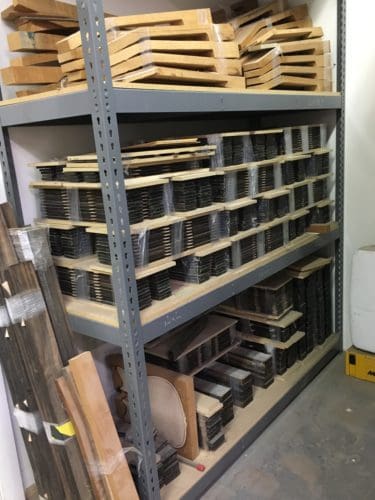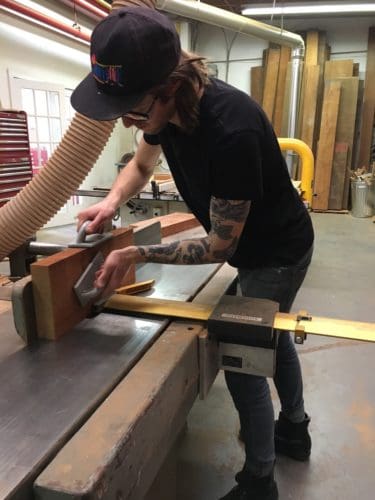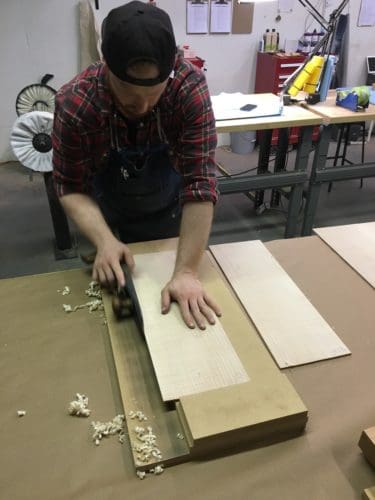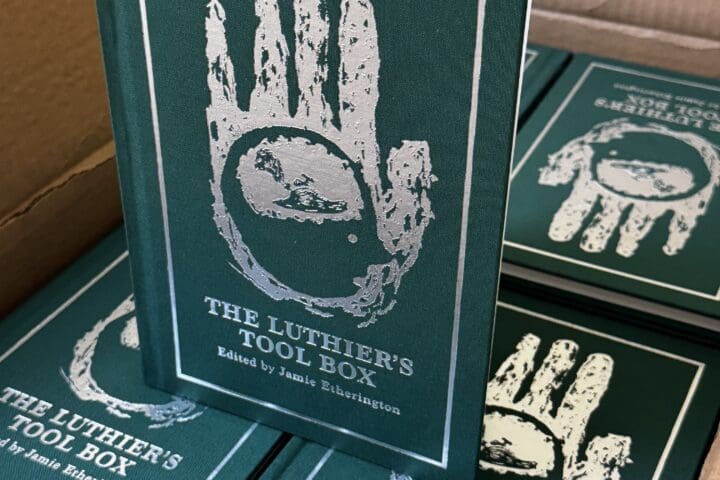Since 2013 Jon, Nick and Tim Frank have building electric guitars as the Frank Brothers Guitar Company. We’d caught glimpses of their instruments here and there but didn’t get a real close look until our friends at The Music Emporium started carrying these original-but-classic-looking guitars. Now, as anyone who’s been paying attention can tell you, we love Telecasters and their variations both traditional and not-so-much, but our interest is always piqued by builders who can find a way to create something original that still feels classic–fresh but not jarring. The Frank Brothers guitar is right there in that sweet spot.
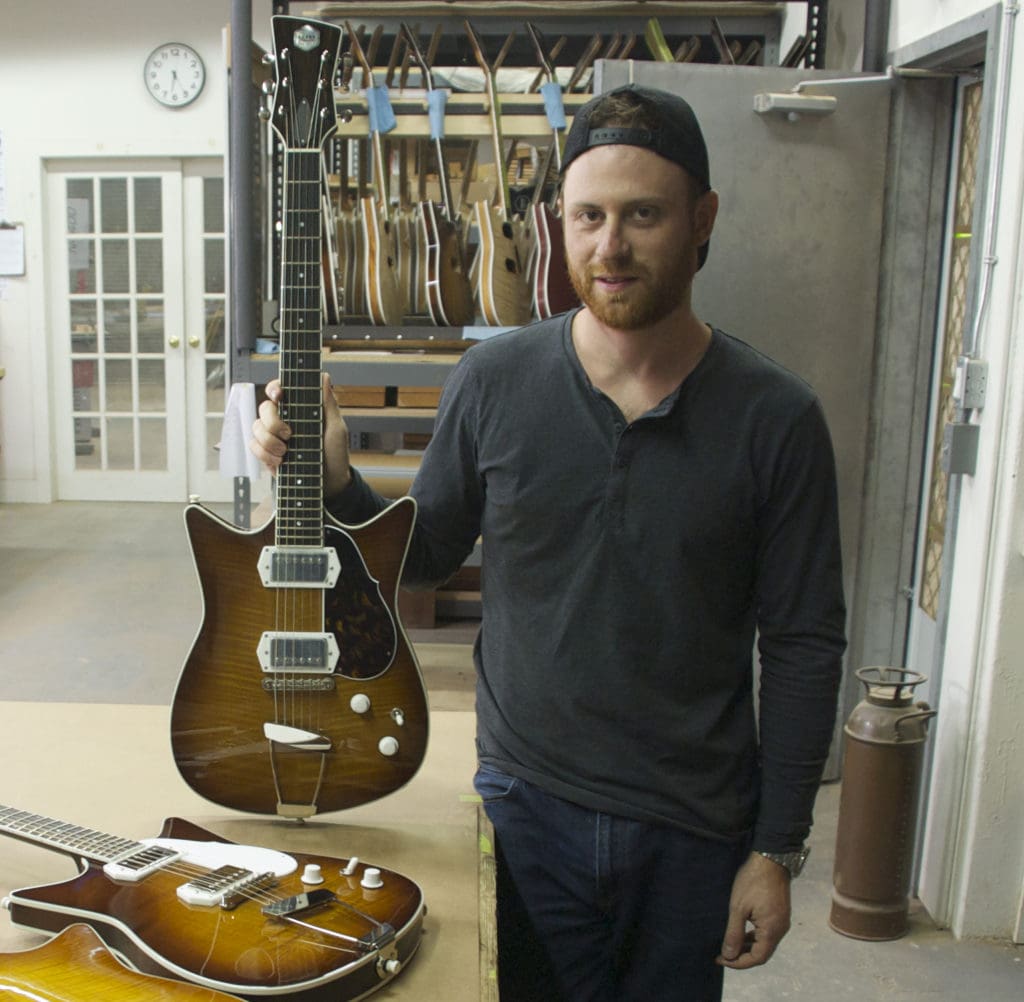
Fretboard Journal: What’s on your bench right now?
Frank Brothers: A Trans-Red Signature Model which we just may have to call Cabernet Frank! Also, a Walnut stained guitar and an Au Naturel guitar that isn’t tinted or stained. To date we’ve only done our Signature Model in two sunburst options so it’s fun to see guitars in different finishes . The sunburst is such a cool and uniquely guitar-esque paint choice that suits our aesthetic perfectly, but we’re loving the look of the red, walnut and natural guitars. Opening our color pallet is something we’re trying to approach thoughtfully.
On top of that, we have some guitars that are being assembled, and others at different stages of finishing, sanding and rough woodwork. We always have a number of guitars in each stage of the process at a time.
Our friend and collaborator Mark Kett is also at a bench in our shop right now working on some of our original tailpieces. They’re polished like a piece of jewelry but built like a tank! Aside from being a great guitar maker, inlay artist and jack-of-all-trades in the luthier world, Mark works with us on integrating CNC into many aspects of our production.
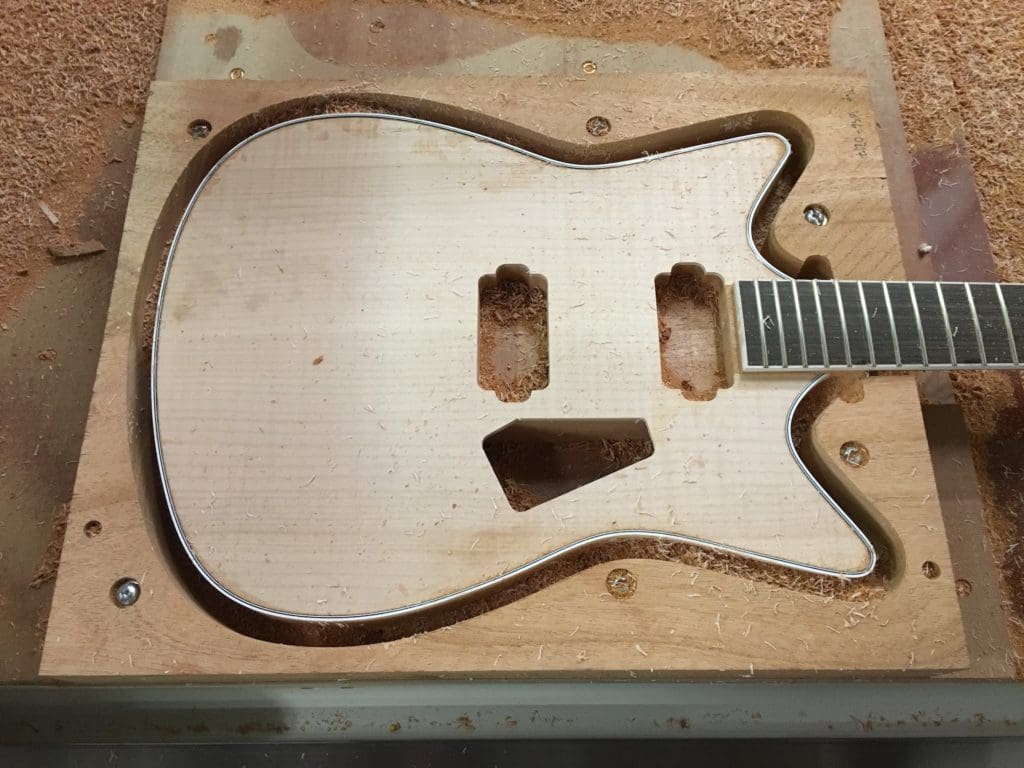
FJ: How did you get started?
FB: We grew up in a musical family and we were encouraged by our parents to play music from a young age.
Our father was an award-winning recording engineer in music, TV and film who worked with artists such as Alice Cooper, The Guess Who and Peter Gabriel.
Our grandfather, Philip Frank, was first violin and concertmaster for Arturo Toscanini’s NBC Symphony Orchestra. He had the rare opportunity to play instruments made by both Guarneri and Stradivarius. We think our fascination with music and the concept of building instruments developed from our interest in his career and experiences with those famous violins.
All three of us started learning guitar when we were young. It wasn’t long after starting lessons that Nick and Tim began to obsess over all things guitar. They tinkered with their own guitars in high school, and were soon repairing their friends’ guitars as well. They built their first guitars while they were in college and, after graduating, rented a workspace at a shared sculpture/woodworking studio in Toronto, where they built, repaired and refinished guitars.
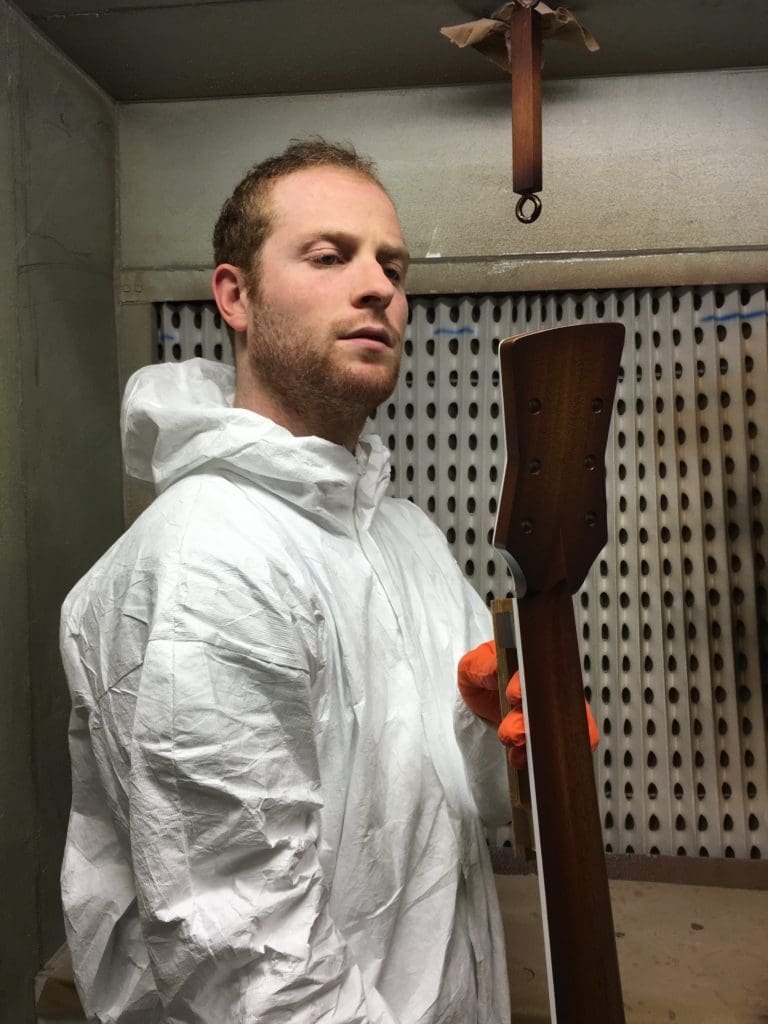
FJ: How does the dynamic and the division of labor work, fraternally speaking?
FB: We collaborate on pretty much everything, but over time we’ve each specialized in certain things. Nick and Tim are twin brothers and are the luthiers and designers behind Frank Brothers Guitar Co. Nick manages woodworking, while Tim handles finishing and assembly. Jon, who is the oldest brother, is focused on the business side of things. This gives Nick and Tim the ability to focus all their energy on the guitars.
We hold each other to very high standards which is easy when you work with your brothers. We’re super honest with each other, and that has contributed to the high quality of the guitars.
We also have a new team member, Simon Outhit, who joined us in 2016. Simon had previously spent time in Bolivia working with a traditional instrument maker, building charangos and other stringed instruments. He has a great eye for detail and is an excellent craftsman.
FJ: Can you tell us about your shop?
FB: We’re in the Studio District in Toronto’s east end where a lot of the city’s film and television industry is located. We’ve got about 2600 square feet with lots of natural light that pours in through a few skylights, which is our favorite thing about the space. Our unit was added in the 1950s, but the building has been around for over 100 years. We opened here in 2014.
We have the space divided into two sections. A woodshop, where we have our heavy machinery and rough lumber storage, and an area we call the studio, where we have our spray booth, office, assembly and set-up work benches and our milled wood storage. We monitor humidity in our shop carefully and recently installed an automatic misting humidifier, which helps keep our space at a relative humidity of 45%.
We’re the type of people who can’t get any work done unless our desk is clear, so we do our best to keep the shop very tidy and organized. Each area is set up for workflow efficiency and easy organization.
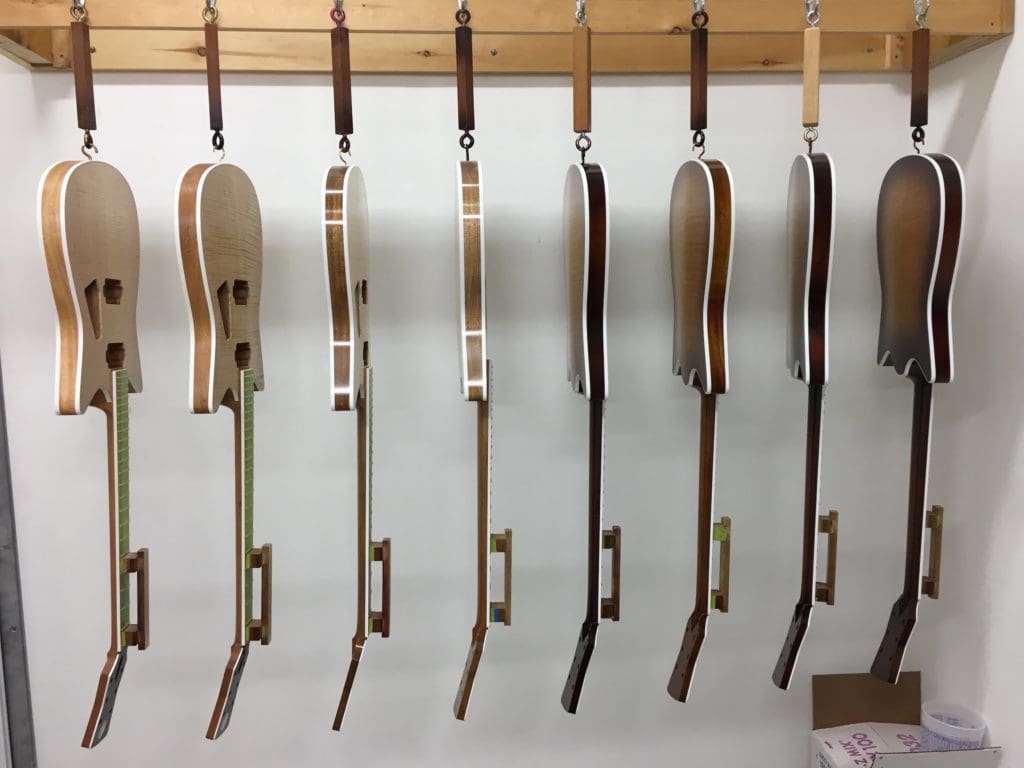
FJ: You only make the one model, though it seems as though there might be some pickup variations. That’s rare these days; how’d that come about?
FB: Our concept behind making only one model was simply to focus on one thing and do it exceptionally well.
We’ve carefully curated our instruments so that they have an original and timeless look and sound and we want to thoughtfully develop any hardware, color and pickup options to meet that criteria. As a result, we currently don’t offer very many options on our guitars and each one comes stock with Lollar El Rayo humbuckers.
FJ: While we’re on the subject, can you tell us about the guitar? I’m particularly curious about how you’re arching the core and the back/top…
FB: We build the Signature Model in a fairly unique way. The arch is carved into the body core, and the top and back are glued to the core using molded cauls. The body also tapers in thickness at the edge. The combination of the taper and arching gives our guitars a totally unique and dynamic look and feel that’s more akin to the subtle arching and precise geometry of an acoustic guitar.
Each guitar is made with genuine mahogany, big leaf curly maple, and Macassar ebony. The maple top and back are nearly identical because they are sawn out of the same billet, and the Macassar ebony headstock overlay is book-matched to compliment the book-matched maple top and back.
Some other unique appointments on our guitars are the pickup surrounds and pickguard, which we make ourselves. The pickup surrounds are machined on the underside to match the arch of the top, and they are also tapered to match the neck angle. This makes the face of the pickups parallel with the strings and has a huge impact on the sound of the humbuckers. We feel it really brings out the most in the pickups.
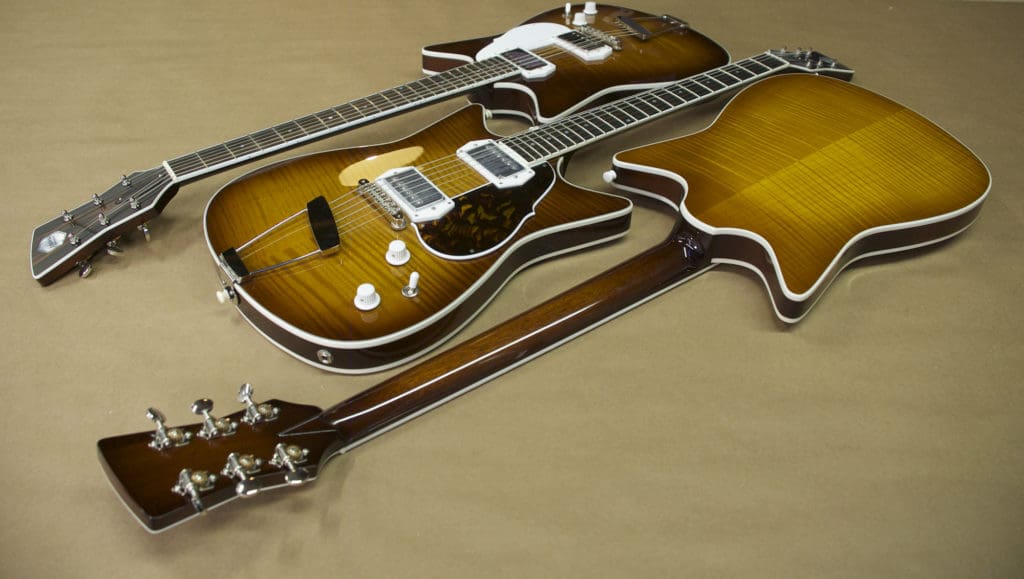
FJ: Where do you find inspiration?
FB: Overall, the Signature Model is a combination of a lot of influences but doesn’t lean heavily on one particular design from the past. We were inspired by Kay, Harmony, Danelectro and Eko, to name a few. We fell in love with their wacky designs and super cool proprietary parts and wanted to fuse that vibe with our own design aesthetic while also making an instrument that would be very usable in the studio and onstage… and not freak people out too much.
We also love the work of modern boutique builders like Joe Yanuziello. He is an incredible craftsman and we love his design sense. Toronto is home to lots of excellent guitar makers who are all incredibly nice people. We’ve had the good fortune to befriend and learn a lot from luthiers like Joe, Alistair Miller, Tony Duggan-Smith, Dave Wren and Mark Kett. Other Toronto luthiers like Linda Manzer and Grit Laskin have definitely had an impact on us as well. We’re also big fans of the classics. Growing up, Jon had a Les Paul, Tim had a Strat and Nick played our dad’s ‘73 Fender P-Bass.

FJ: Given your Chairman, Warren Spitz, is wood importer/exporter/dealer, we’re guessing you guys are particular about wood/materials. What’s your approach/philosophy?
FB: High quality wood is the foundation of most good instruments and having a partnership with a specialty wood company is a fantastic asset. Warren and his team’s 30 years of experience in the wood importing industry help us to source materials that meet the highest standards of quality and responsible forestry practices. This relationship also gives us a lot of transparency when purchasing wood. We’re often in touch with the sawers and lumber mills directly and know exactly where our wood is coming from.
Warren and his business are global leaders in sustainable forestry and that is something that is important to us. Forest ecosystems are critical for our planet and at the same time a consistent source of hardwoods is critical for our business, so we have a high degree of environmental consciousness, and we try to extend that to all areas of our business. We see it as an area for continuous improvement at our shop and across the industry.


